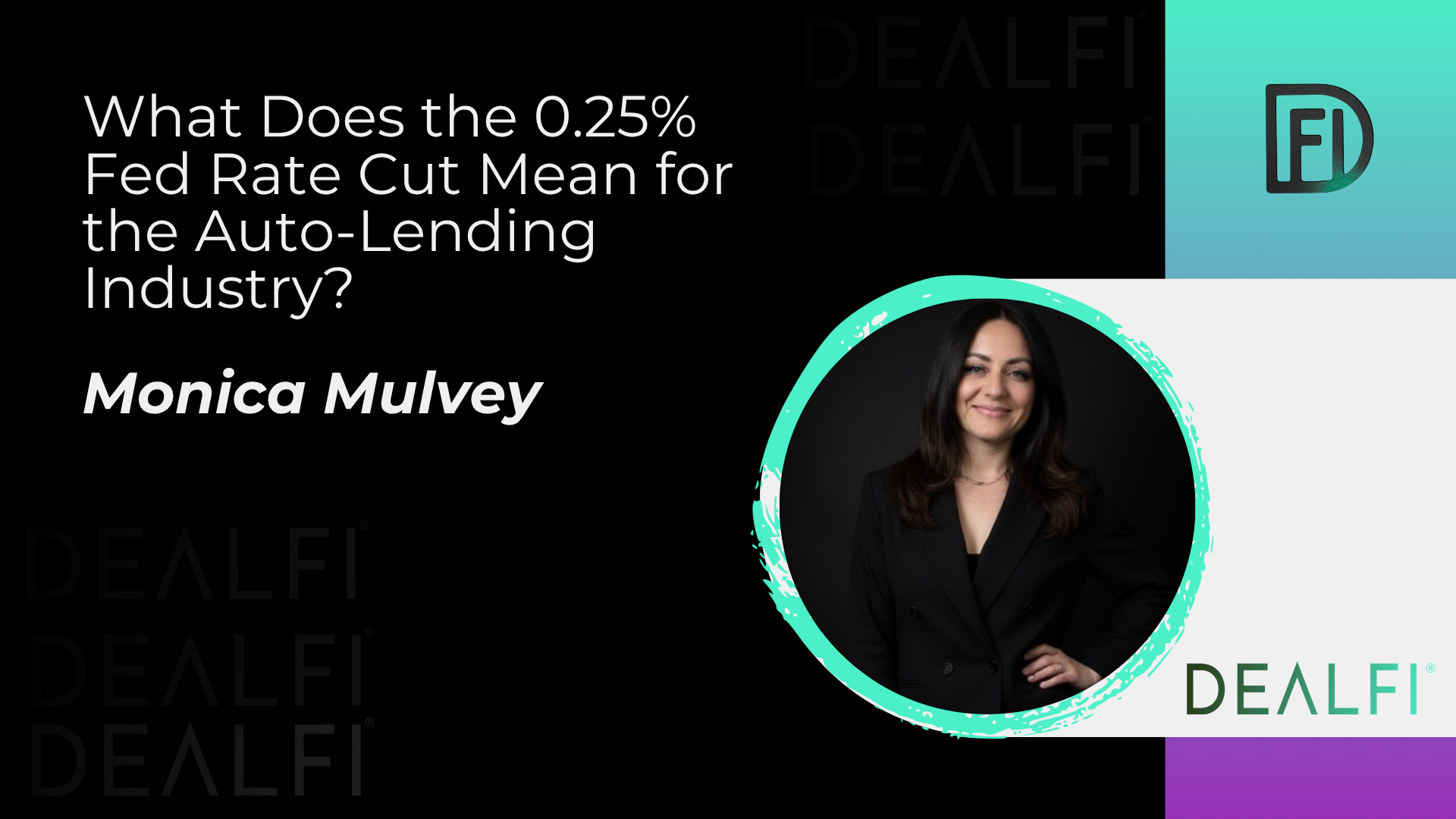
Last month, the Federal Reserve cut its interest rate by a quarter of a percentage point to a range of 4% to 4.25% – the first cut since December 2024 and its lowest level since late 2022.
Not only that but Fed officials have projected that there will be two more 0.25% deductions this year, to a range of 3.5% to 3.75%.
Naturally this will affect the auto lending industry and we're expecting short, medium and longer-term impacts as a result.
Let's dive into what this means for auto lenders.
What should improve for auto lenders right away?
There are some immediate benefits of the rate cut for the auto lending industry:
Lower short-term borrowing costs
The amount that banks, credit unions, and other auto financing companies borrow is partly tied to short-term rates. For example, lenders might borrow funds from wholesale markets, issue asset-backed securities, or use revolving credit facilities. Each of these is sensitive to base rates.
When the Fed reduces its benchmark rate, this directly lowers the cost of funds for lenders.
As a result, lenders can either free up headroom in their margins by maintaining their current loan rates or pass the savings onto borrowers to provide better financing deals and attract more applications.
In lots of cases, lenders will do a mix of both, to boost volume while maintaining a steady profitability.
Increased demand for financing
Lower interest rates can make a noticeable different in month loan payments for borrowers, particularly for buyers who were on the margin (i.e. the cost of financing was just too high), increasing the demand for financing and boosting overall volume.
Consumer confidence can also increase, giving dealerships the opportunity to respond with targeting marketing, e.g. 'Now's the time to buy', as a demand trigger.
Credit risk easing
When the cost of borrowing falls, consumers with revolving or variable-rate loans see some relief. This improves their ability to make their monthly payments on time, lowering delinquency rates for lenders, and ultimately lowering the risk associated with the loans.
Lower benchmark rates also make refinancing easier for at-risk or subprime borrowers which, over time, translates to better credit quality in a lender's portfolio and a greater willingness to offer credit to borrowers with moderate risk.
What should improve for auto lenders gradually?
Short-term gains for lenders come from more affordable funding and increased volume. But the bigger wins often emerge more gradually as the market adapts to the new rate environment.
Auto loan rates may ease over time
While the cost of auto loans is influenced by the Fed funds rate, there are several other factors that contribute to the price consumers pay, including longer-term yields, credit spreads, securitization costs, and borrower risk profiles. These don't always align with the base rate.
This means lenders don't reprice overnight. But over time, as capital markets stabilize, they should be able to strategically pass savings onto their customers – through selective rate promotions, extended loan terms, or by offering lower APRs to high-performing borrowers.
It's a slow but meaningful shift that increases both competitiveness and borrower affordability in the medium term.
Funding benefits take time to flow through portfolios
There's always a lag between policy action and real-world borrowing conditions.
This is because it takes time for:
- Lenders to adjust pricing models
- Funding costs to filter through the ABS market
- Dealers to recalibrate promotions
Despite this, there will always be lenders who move early to capture market share, while others wait for more rate clarity. This staggered response means the overall effect on the market builds gradually rather than overnight.
Market stabilization supports long-term growth
If rate cuts are reflective of a broader easing cycle, it gives lenders the opportunity to plan with more predictability. This might include expanding their dealer network, embedding new finance partnerships, or investing in digital origination tools.
Risks, constraints, and what might hold things back
While rate cuts are generally positive for the auto lending industry, there are several external factors that can limit the real-world impacts.
Car pricing and vehicle supply chains
Auto lending is affected by the cost of the vehicles themselves, as well as supply chain issues, inventory constraints, and manufacturer incentives (or lack thereof).
If vehicle prices stay high or there are issues with the supply chain, the benefit to buyers (and ultimately lenders) will be lessened, regardless of cheaper financing costs.
Inflation and long-term rates
Everyone – lenders, dealers, and buyers – has been affected by inflation over the past several years, and if inflation remains elevated, longer-term rates (e.g. 10-year yields) are unlikely to fall.
This means financing for multi-year longer-term loans may stay high.
Regulatory and capital constraints
Lenders operate within strict regulatory frameworks that limit how quickly they can expand credit. In practice, finance companies must maintain minimum capital rations and loan-loss reserves, which can result in a more cautious recovery in lending activity – particularly in subprime segments.
Over time, if credit performance stabilises, these constraints can be eased – but there's no guarantee that this will happen.
Final thoughts
In the main, Fed rate cuts are a net positive for the auto lending industry.
In the short to medium-term, lenders can expect modest but meaningful gains – lower funding costs, improved financing conditions, and a gradual uptick in consumer demand.
In the long-term, there will be more pronounced benefits if macroeconomic stability improves, including lower financing costs, more applications, loosening of credit, and lower risk.
At DealFi powered by OttoMoto, we help lenders and dealers move through these cycles, strengthening trust, building lender-dealer relationships, and improving efficiency. Want to find out more? Get in touch today.